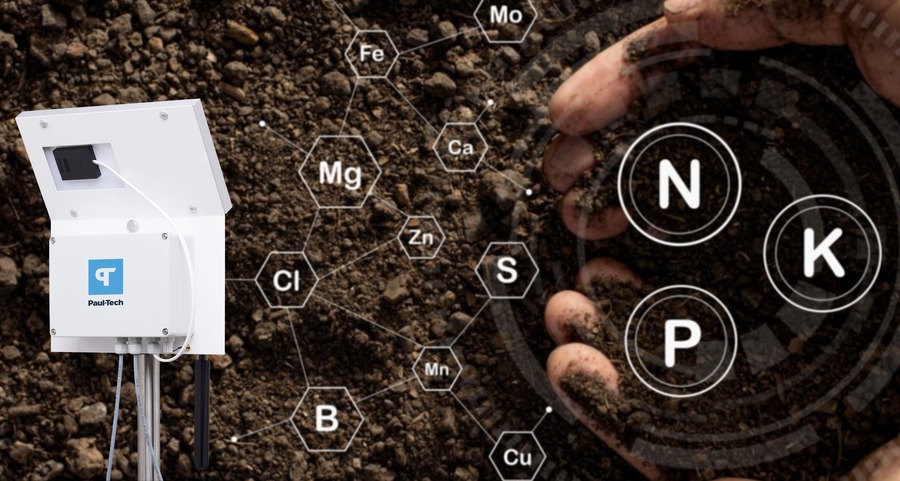
Soil analysis is a valuable tool in agriculture for selecting suitable crops, assessing soil fertility, and providing fertiliser recommendations. To obtain reliable information, it is necessary to take representative soil samples and analyze the soil using methods calibrated with fertiliser trials in the respective region. On the other hand, it has long been observed by several researchers that, under sufficient soil moisture conditions, soil electrical conductivity (EC) describes plant growth conditions well or even better than soil analyses. However, correlations between EC and nutrient levels found in soil analyses have been inconsistent.
Macronutrients in soil
The main macronutrients in soil, which are determined through analyses, include nitrogen (N), phosphorus (P), and potassium (K), which are required in large quantities by plants. Secondary macronutrients like calcium (Ca), magnesium (Mg), and sulfur (S) are also important, but deficiencies and the need for their addition are less common in crop cultivation. Typically, soil analyses are conducted in early spring, when the level of nitrate (NO3), the most crucial plant-available form of nitrogen, is low in the soil. The total nutrient content in soil is much greater than the portion available to plants. For instance, potassium makes up approximately 1% of the world’s soils (as referenced in Soil Chemistry by H.L. Bohm, B.L. McNeal, and G.A. O’Connor, John Wiley & Sons, 2001), but the plant-available fraction in soil tests is around 100-200 mg/kg, which is only 1-2% of the total K content.
Soil sampling: how and what is measured
The same principle applies to all plant nutrients. Therefore, laboratory methods have been developed to specifically determine the plant-available nutrients, and these methods are validated through fertilisation trials. In Europe alone, 12 different soil analysis methodologies are used, employing various extraction solutions, meaning that results obtained from different laboratories are not directly comparable. During these analyses, a specific amount of extraction solution (e.g., Mehlich 3, AL, DL) is added to the soil, shaken for a set period, and the nutrients extracted into the solution are measured. Standard spring soil analyses (required every 5 years) typically measure K, P, as well as Mg and Ca content in mg/kg.
The role of electrical conductivity in soil data
Plant nutrition occurs through the water present in the soil, where nutrients are dissolved. This is the medium from which plants directly absorb nutrients through their roots. Dissolved ions in soil water cause electrical conductivity, and the total amount of ions can be universally estimated by measuring the electrical conductivity of a saturated soil extract, which is the Paul-Tech nutrient indicator. Phosphorus is usually strongly bound to soil particles in a non-water-soluble form, so its movement is not reflected in electrical conductivity. Key cations like K+, Mg++, and Ca++ are more or less bound to the soil structure (negatively charged colloid particles) through the cation exchange capacity (CEC) phenomenon.
Whether or not these exchangeable cations dissolve in soil water or sit on exchange sites, depends on many factors, particularly soil texture (the clay content, which determines the CEC value), organic matter content, temperature, soil moisture, and more. For example, it is known that K+ ions bind relatively quickly and strongly to soil particles, and this process is also influenced by winter freezing-thawing cycles, which is reflected in Paul-Tech’s nutrient value. The strength of cation binding to the soil matrix determines their leaching potential; for example, soils with higher clay and/or humus content (higher CEC) have little risk of K leaching, whereas sandy soils (low CEC) are at higher risk.
In traditional soil analyses, the total pool of potentially plant-available nutrients is determined using extraction solutions, whereas the Paul-Tech system measures in real time the sum of nutrients currently available to plants in the soil solution.
Summary:
- The total nutrient content in soil is 10 to 100 times greater than the portion that is plant-available (the part that influences plant growth).
- In soil laboratory analyses, nutrients are extracted from the soil using different extraction solutions, and it is unclear, and may vary over time, how much of the nutrients obtained in these analyses (the total soil nutrient content) are currently available to plants. The analysis methods are calibrated with fertilisation trials and are specific to the local context.
- Plant nutrition occurs through the soil water solution. Measuring electrical conductivity and calculating nutrients from this in the Paul-Tech system describes the real situation in the soil water near the root zone (and not the extraction solution) in real time.
- For long-term soil fertility management, the laboratory analyzes using extractant solution is essential as it shows the total nutrient reserve, even those not immediately available.